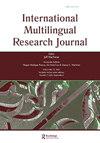森语中的抱负
IF 2.1
1区 文学
Q2 EDUCATION & EDUCATIONAL RESEARCH
International Multilingual Research Journal
Pub Date : 2020-12-19
DOI:10.26499/multilingual.v19i2.161
引用次数: 0
摘要
森语中的词缀具有多种形式和功能。本文对森语中词缀的形式和功能进行了研究。本研究旨在描述森语中词缀的形式和功能。收集数据的方法是参与式方法。通过代入技术,采用语内对应法对数据进行分析。研究结果表明,森语的词缀形式可分为前缀、内缀、后缀、连缀和复合词缀。共有8个前缀,如moN-、meN-、poN-、te-、pe-、in-、poko-和um-。MoN-和poN-前缀要么嵌入基形中,要么嵌入前缀词中。发现的固定字是-in和-um。内嵌是嵌入在基础形式或在固定形式。发现的后缀由三个后缀组成,即-o, -a和-i。在森语中,连音有三个,它们是a-a, po-a和pe-a。词缀的组合有五种,即n-ako、meN-ako、i-in、in-ako和in-i的词缀。前面提到的词缀有构成动词和名词的作用。此外,词缀还具有改变词根的部分词性和确定词根意义的作用。本文章由计算机程序翻译,如有差异,请以英文原文为准。
Afiksasi dalam Bahasa Mori
Affixation in Mori language has various forms and functions. The research studies about how the form and function of affixation in Mori language are. The research intends to describe the form and function of affixation in Mori language. The method used in collecting data is the participatory method. The data is analyzed using the intralingual correspondence method through the substitution technique. The result of research illuminates that the form of affixation in Mori language is classified as prefixation, infixation, suffixation, con-fixation, and affixation combined. There are eight prefixations found, such as moN-, meN-, poN-, te-, pe-, in-, poko-, and um-. MoN- and poN- prefixation are embedded either in the base form or prefixed word. Infixations found are -in- and -um. Infixation -in- is embedded either in the base form or in the affixed form. Suffixation found consists of three suffixation, namely -o, -a, and -i. in Mori language, confixation are three, they are a-a, po-a, and pe-a. Combinations of affixation are five, affixation of moN-ako, meN-ako, i-in, in-ako, and in-i. Affixation aforementioned functions to form verb and affixed noun. Besides, affixation also functions to change part of the speech of the base form and confirms the meaning of its base form.
求助全文
通过发布文献求助,成功后即可免费获取论文全文。
去求助
来源期刊
CiteScore
4.10
自引率
4.80%
发文量
19
期刊介绍:
The International Multilingual Research Journal (IMRJ) invites scholarly contributions with strong interdisciplinary perspectives to understand and promote bi/multilingualism, bi/multi-literacy, and linguistic democracy. The journal’s focus is on these topics as related to languages other than English as well as dialectal variations of English. It has three thematic emphases: the intersection of language and culture, the dialectics of the local and global, and comparative models within and across contexts. IMRJ is committed to promoting equity, access, and social justice in education, and to offering accessible research and policy analyses to better inform scholars, educators, students, and policy makers. IMRJ is particularly interested in scholarship grounded in interdisciplinary frameworks that offer insights from linguistics, applied linguistics, education, globalization and immigration studies, cultural psychology, linguistic and psychological anthropology, sociolinguistics, literacy studies, post-colonial studies, critical race theory, and critical theory and pedagogy. It seeks theoretical and empirical scholarship with implications for research, policy, and practice. Submissions of research articles based on quantitative, qualitative, and mixed methods are encouraged. The journal includes book reviews and two occasional sections: Perspectives and Research Notes. Perspectives allows for informed debate and exchanges on current issues and hot topics related to bi/multilingualism, bi/multi-literacy, and linguistic democracy from research, practice, and policy perspectives. Research Notes are shorter submissions that provide updates on major research projects and trends in the field.

 求助内容:
求助内容: 应助结果提醒方式:
应助结果提醒方式:


